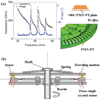Advantages and Challenges of Relaxor-PbTiO3 Ferroelectric Crystals for Electroacoustic Transducers- A Review
- PMID: 25530641
- PMCID: PMC4267134
- DOI: 10.1016/j.pmatsci.2014.10.002
Advantages and Challenges of Relaxor-PbTiO3 Ferroelectric Crystals for Electroacoustic Transducers- A Review
Abstract
Relaxor-PbTiO3 (PT) based ferroelectric crystals with the perovskite structure have been investigated over the last few decades due to their ultrahigh piezoelectric coefficients (d33 > 1500 pC/N) and electromechanical coupling factors (k33 > 90%), far outperforming state-of-the-art ferroelectric polycrystalline Pb(Zr,Ti)O3 ceramics, and are at the forefront of advanced electroacoustic applications. In this review, the performance merits of relaxor-PT crystals in various electroacoustic devices are presented from a piezoelectric material viewpoint. Opportunities come from not only the ultrahigh properties, specifically coupling and piezoelectric coefficients, but through novel vibration modes and crystallographic/domain engineering. Figure of merits (FOMs) of crystals with various compositions and phases were established for various applications, including medical ultrasonic transducers, underwater transducers, acoustic sensors and tweezers. For each device application, recent developments in relaxor-PT ferroelectric crystals were surveyed and compared with state-of-the-art polycrystalline piezoelectrics, with an emphasis on their strong anisotropic features and crystallographic uniqueness, including engineered domain - property relationships. This review starts with an introduction on electroacoustic transducers and the history of piezoelectric materials. The development of the high performance relaxor-PT single crystals, with a focus on their uniqueness in transducer applications, is then discussed. In the third part, various FOMs of piezoelectric materials for a wide range of ultrasound applications, including diagnostic ultrasound, therapeutic ultrasound, underwater acoustic and passive sensors, tactile sensors and acoustic tweezers, are evaluated to provide a thorough understanding of the materials' behavior under operational conditions. Structure-property-performance relationships are then established. Finally, the impacts and challenges of relaxor-PT crystals are summarized to guide on-going and future research in the development of relaxor-PT crystals for the next generation electroacoustic transducers.
Keywords: Crystals; Electroacoustic; Ferroelectric; Piezoelectric; Relaxor-PT; Transducers.
Figures













































References
-
- Carlin B. Ultrasonics. New York: McGraw-Hill; 1960.
-
- Ensminger D, Bond LJ. Ultrasonics: Fundamentals, Technologies, and Applications. New York: CRC Press; 2011.
-
- Sherman CH, Butler JL. Transducers and Arrays for underwater sound. New York: Springer; 2007.
-
- Narouze SN. Atlas of ultrasound- guided procedures in interventional pain management. New York: Springer; 2010. - PubMed
-
- Cheeke JDN. Fundamentals and applications of ultrasonic waves. New York: CRC Press; 2012.
Grants and funding
LinkOut - more resources
Full Text Sources
Other Literature Sources
